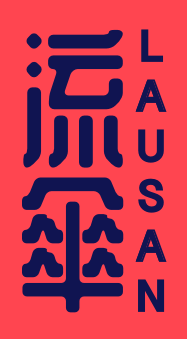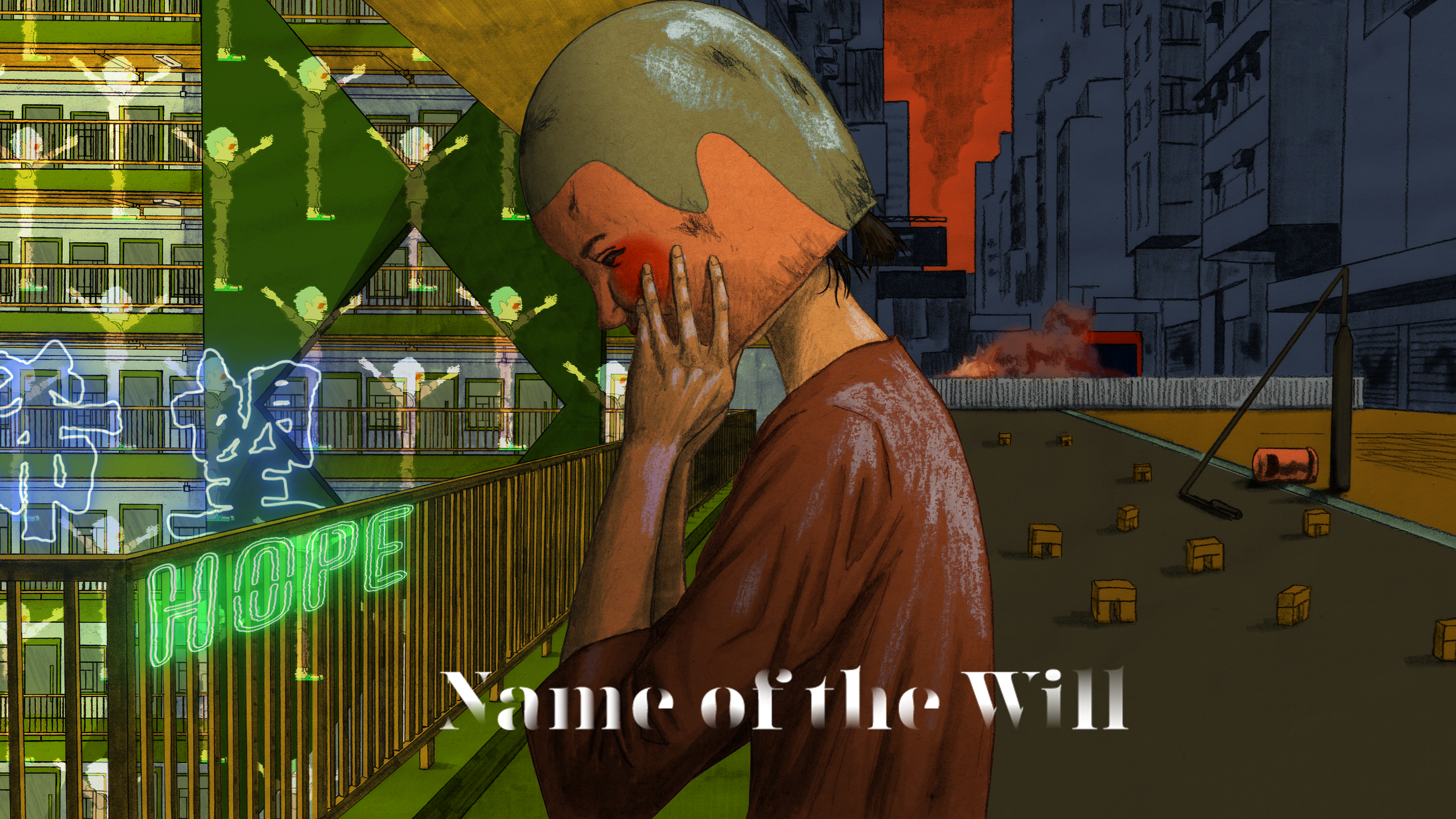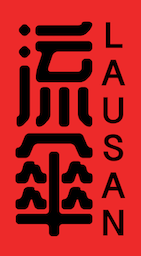This interview has been lightly condensed and edited for clarity. All images are courtesy of Zeitgeist Studio.
To support Name of the Will, visit their Kickstarter page for more information on funding by March 8, 2021.
The 2019 protests in Hong Kong have inspired a slew of video games, from the action role-playing game Legacy of Datura, the virtual reality protest simulator Liberate Hong Kong, to the anti-protest browser game Everyone Hit the Traitors. Developed by local indie studios and dedicated individuals, the video game is a potent and dynamic medium for players and game designers to explore the emotions, stories, and ideas of the anti-extradition movement.
In development by the Brooklyn-based Zeitgeist Studio, Name of the Will (集體後遺症) is a story-driven adventure game set in a Kafkaesque vision of a Hong Kong overseen by beast-masked Governors and populated by neighbors who bear the smiling visage of the Big Headed Buddha. Name of the Will will feature an evocative setting, iconic hand-drawn art style, original soundtrack, and thought-provoking gameplay that gives weight to the player’s individual decisions.
Lausan member WF interviewed Zeitgeist Studio developers Mandy Wong and Jerry Chan to find out more about the influences that have inspired the game, and the overarching themes and experiences they hope to deliver.
WF: Why did you choose a video game as the storytelling medium? How did the Name of the Will development team come together?
Mandy Wong and Jerry Chan: Zeitgeist Studio has four members. All of us are Hongkongers of different backgrounds, dispersed across the world. Our team includes artists, multimedia producers, and game programmers. At the beginning of the 2019 Hong Kong protests, Mandy and our programmer wanted to make a game responding to their experiences back then; they developed the blueprint of this game. As for us, we were MFA classmates. Jerry joined the team as his art resonates with the game concept. We also found another friend to write the script together and to serve as our puzzle designer.
We formed our relationships with each other at different times, some existing for over a decade, some for only a year. At this challenging time, amidst the pandemic and social discontent, we don’t take any of our relationships for granted. We consider it our most immense privilege to be a part of this team.
All members of our team are video game lovers. What’s more, we found that video games are an excellent medium to encourage people to engage in the story and reflect on it. The interaction between the game and the gamers is not just a flash in the pan because people tend to spend a couple of hours on the game at a time. Players can’t complete missions and proceed if you don’t concentrate on the game. In other words, the gamers are compelled to stay focused and keep thinking.
Also, gameplay is an immersive experience that is different from films and art exhibits. Most of the time, you’re intimately experiencing the game in a relaxed and comfortable environment, such as your home. Every element in the game—plots, sounds, lines, or puzzles—could easily be a stimulation. During gameplay, you may express your emotions freely, while the game provides you with room to contemplate.

WF: Why did you choose the puzzle-adventure genre for your game? This is as opposed to, say, an action-RPG type game as was the basis for Legacy of Datura?
MW and JC: We don’t consider Name of the Will a classic puzzle-adventure game, nor a horror game. Since it is not easy to define its genre, we tend to put it into the category of ”video game art.” We utilize art to construct an experience and develop a narrative. We never attempt to include jump scares or extrasensory factors in the game. Nevertheless, this game requires extensive thinking and moral judgments.
Name of the Will is a game that seeks to profoundly reflect reality. Even though it is somewhat surreal and uncanny, it is closer to a simulation of the real world [than to a wholly fictional setting]. We believe that nothing is more horrifying and absurd than real life.
Our purpose is threefold: to present a general scenery of dictatorship; to give the player room to ponder and introspect on what they are experiencing; and to provide ways for the player to develop their own individual ending.
There isn’t a model answer or clear definition of winning the game. What really counts is whether you have your favorite ending. If you can lead yourself to the ending you desire, you may consider yourself a winner. During the journey, you will come across many junctures for decision-making. Some will be easy, while some will be tough, but each of them will be significant enough to change your fate in the game. We want to convey that the world does not necessarily change for you, but you can make a change in yourself.
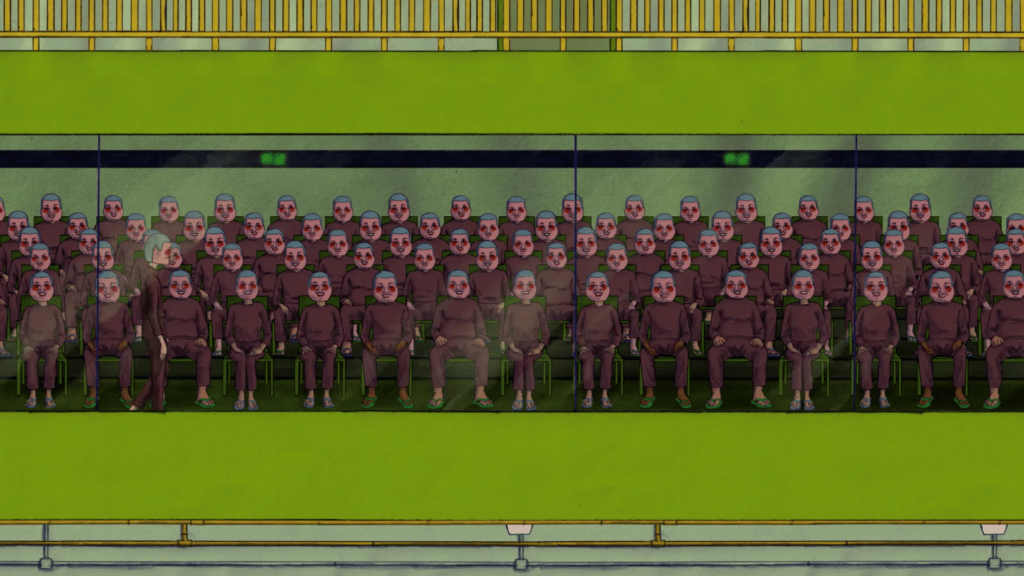
WF: Could you tell us about the inspirations for Name of the Will? Were there any media that had a significant influence on the design choices made in the development of the game? What were the influences on the visuals/aesthetics and character design of the game?
MW and JC: Besides the social movements in Hong Kong and its history, we’re highly influenced by two books, The Rebel by Albert Camus, and On Violence by Frantz Fanon. We also referred to other revolutions, protests, and dictatorship cases around the globe, such as the political situation of Uyghurs in Xinjiang and the Egyptian revolution of 2011. Inspired by grassroots movements and activism in the US and other countries, we realized there’s a need for long-term work in Hong Kong to document and reflect on what we’ve been through in the past few years. There may not be an instant outcome, but I believe it would be valuable for the future. This is exactly the obligation of a cultural worker or artist.
For Sama, a documentary of the Syrian civil war, shocked and inspired us. The civil war began as a peaceful student protest but ended up inciting a bloody regional conflict. While the citizens were living at the edge of death, you could surprisingly see them continue to dance, laugh, love, and live a life. These were decisions they made to continue with their lifestyle. In For Sama, the filmmaker notes that “[to live] normally in this city is the biggest gesture of rebellion against the regime.” Given the devastating situation, continuing to live on well is a clear representation and outcome of one’s will.
In Hong Kong, people are living under increasing government suppression. While facing a crumbling home, some will leave; some will stay; some will succumb to the pressure; some would ignore the oppression; and some will fight against it. People have to choose for themselves in these insecure circumstances.
We also took inspiration from Animal Farm, Attack on Titan, Beholder, and The Butter Battle Book, which sarcastically reflect the political atmosphere and human nature at the time. The successful development of Red Candle Games in Taiwan was also a great motivation for our team.
In terms of visuals, we referenced an experimental comic book, Here, created by Richard Mcguire. He works with an exceeding variety of color schemes. The book also spectacularly demonstrates how one can use framing to construct a narrative. Being interested in comics and hand-drawn animations for years, we have utilized their languages in the trailer, and you’ll see more in the actual game.
We believe that nothing is more horrifying and absurd than real life.
We also referred to diverse and countless elements from Hong Kong that you’d see in the city. For example, the building Hope in the game is a distinctly Hong Kong-style public housing estate, where a beam of natural light shines through the light-well in the middle of the building. This design was first used in the 1970s but ceased to be used in the 1980s. It was intended to create harmony among residents by letting them see into each other’s apartments through windows. However, that design created a convenient occasion for peeping Toms and coincided with higher rates of depression among its residents. Its architecture is also evocative of the Panopticon, resonating with our depiction of the façade of carefree utopianism in the “Hope” chapter in our game.
Every resident of Hope wears the mask of the Big Head Buddha, referencing a Cantonese figure of speech for troublemakers. Also prominently featured are the neon lights typical of pop culture depictions of Hong Kong. Moreover, the design of the Governors—the guards who police Hope—takes inspiration from the dragon and lion of the British Hong Kong flag, which respectively symbolize China and Britain. The outfit of the woman character, Rita, is also known as a black bloc, a getup of frontline Hong Kong protesters in 2019.
Furthermore, we aim to establish a Hong Kong ethos and style that particularly resonate with the post-90s generation: The city is exhausting at times, determined at times, and it is as lovable as it is despicable. I recently read a comment about our game on the Internet. It says that the typical narrative in the 80s and 90s was often a rags-to-riches story of someone pulling themselves up by the bootstraps—the central tenet of Hong Kong’s “Lion Rock Spirit.” In 2020, however, the desire for hope and freedom has become the most salient theme in Hong Kong production for this generation. Through our game, we want to prompt players to interrogate: What is our hope? Who determines our hope? Who manipulates the definition of hope?
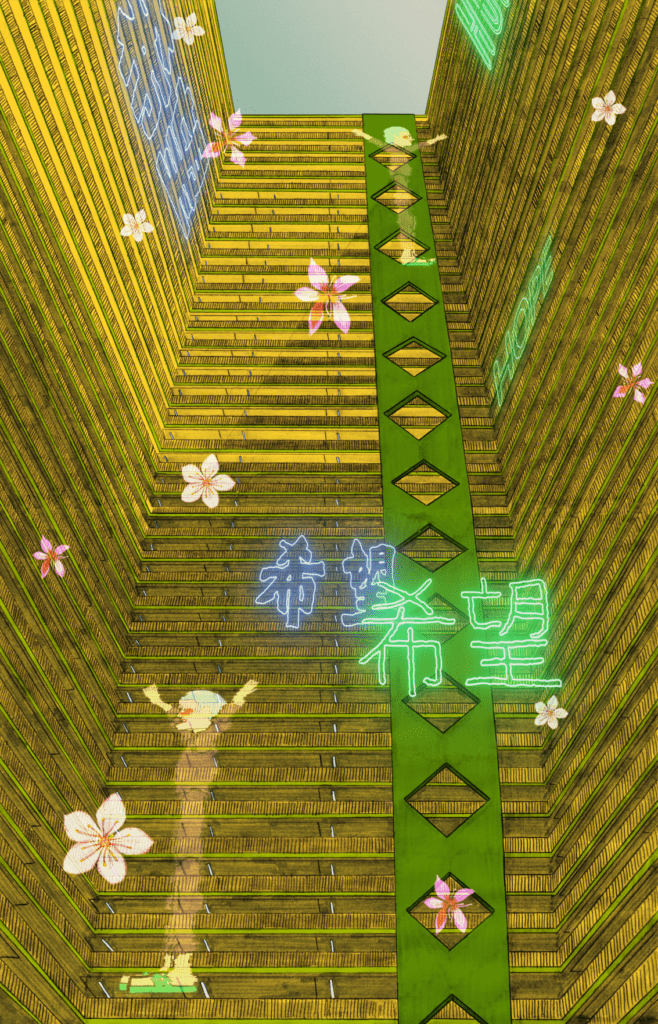
WF: Looking at the character designs for the neighbors, who all wear the same grinning Big Head Buddha mask, I couldn’t help but be reminded of Chinese artist Yue Minjun’s smiling faces. Was Yue’s work an influence?
MW and JC: I’m glad that you asked this question. Indeed Yue Minjun’s work was one of our inspirations, especially The Execution. We were also inspired by the incongruity theory of laughter: Imagine that you’re in deep pain and sorrow. Ironically, your most instinctual reaction may be laughter, as it can function as a response to absurdity and allow us to temporarily suspend the pain. However, our biggest reference for the smiley Buddha mask was the Big Head Buddha figure itself.
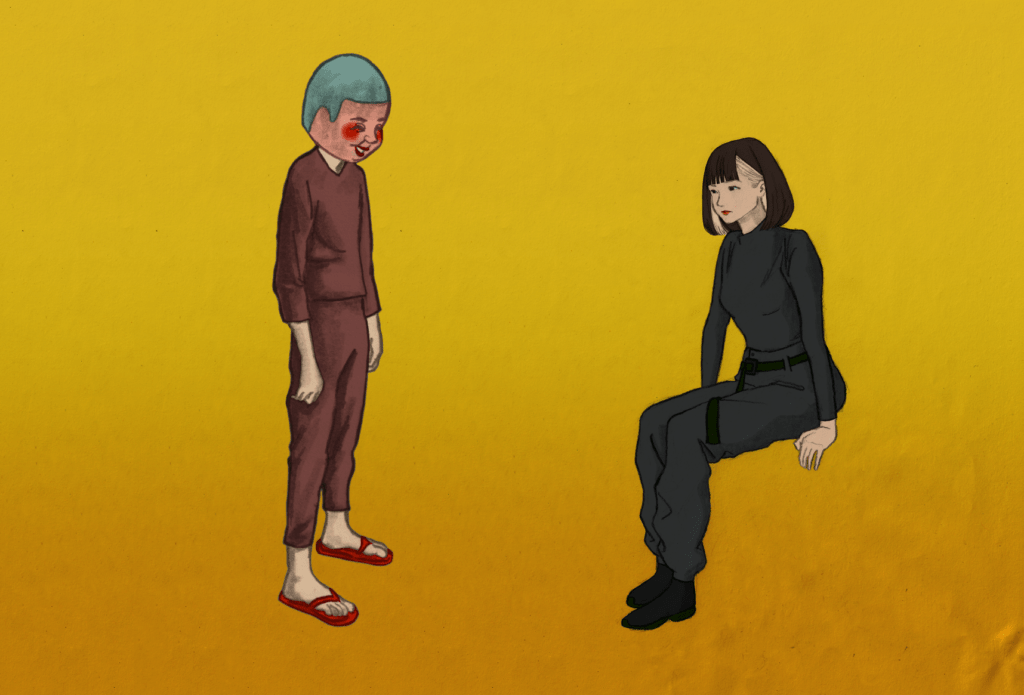

WF: On your Kickstarter page, you mention the centrality of player choice in the game and how the player’s decisions affect which ending they get. Could you give us an example of how the player’s choice will be made meaningful within the game?
MW and JC: In our game, the player, as the protagonist, must make a series of decisions, each of which will affect the protagonist and their neighbors’ fate. Those dilemmas and decisions may prompt the player to consider critical questions, such as: What is the value of one’s integrity? Is sacrificing others acceptable in some situations? What are we actually pursuing? Also, the protagonist will experience hallucinations from time to time. The hallucination would bring the player into various scenarios, and during the process, the player must confront their dark side, and what lies at the bottom of their heart. Only then can the player proceed with the journey.
Our team doesn’t have an answer to these questions either, but they are crucial to consider. Together with the players, we hope that we can get closer to the answers we have been looking for. We believe the journey of the game does reflect reality in the way that our fates are affected by many uncontrollable factors. Yet, we’re the ones who ultimately make the judgment and decision.
After the protests and COVID-19, it seems that many Hong Kong people are rethinking the life they desire. We are all persevering, fighting for our ideal ending. If we can make it in reality, can we consider ourselves a winner?
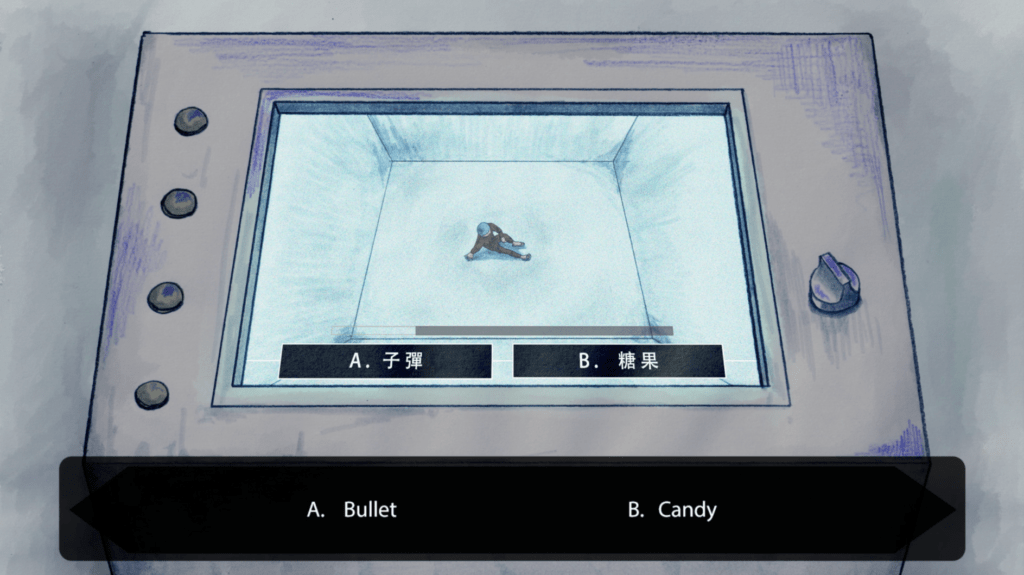
WF: Could you tell us about the thematic narrative of the game? What are the general themes or ideas that the game will try to explore through its narrative?
MW and JC: Through this game, we want to ask players to consider how to live with turmoil, pain and agony, and live on with our free will. We have no intention to emphasize the trauma we have experienced, but rather, to make our most desired choice in the name of the will—that is, the origin of our game title.
We believe Hongkongers, or even the world, have gone through setbacks in many aspects. Some are shared, and some are personal. The insecure environment has highlighted our vulnerability as human beings. At the same time, we have also changed a lot.
We consider this change a sequela. How will this lead us to the future? For us, this sequela is something we can never escape, forget nor erase. Perhaps the only thing we could do is face it, accept our weakness, and live on as a form of rebellion. We believe the theme proposes a way to respect yourself.
With a fictional world, we wish we could connect and influence more people who share similar experiences. We believe that we all struggle with losing our focus and direction. We hope this game can accompany people through this inescapable stage of uncertainty and gently heal their souls. We’re all in this together.
Mandy Wong (co-founder, writer, and artist) is a New York-based Hong Kong digital and performance artist. She received her MFA at Pratt Institute in New York and her BA in Visual Arts at Hong Kong Baptist University. Taking ground from her life trajectory as a Hongkonger, she explores vulnerability, resistance and frustration towards the system. Her works have been exhibited in various places, such as Art Omi (New York), Kunstquartier Bethanien (Berlin), Videotage (Hong Kong), and Hong Kong Visual Arts Centre.
Jerry Chan (co-founder and artist) is a Hong Kong drawing and animation artist based in New York, with a practice of drawing and hand-drawn animation with a multi-narrative approach. He completed his MFA at Pratt Institute in New York and his BFA at the Chinese University of Hong Kong. He has exhibited his works in different countries, including Ethan Cohan Gallery (New York) and Domatio (Greece). He has also curated a few group exhibitions in Hong Kong concerning experimental comics, Achieve Comics, and comics like that.

